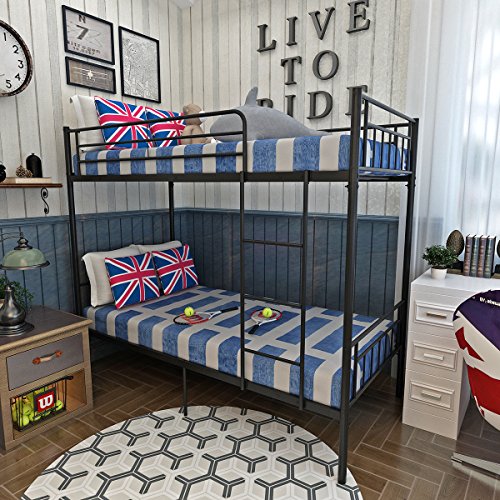Bunk Beds For Kids
Whether they call dibs on the top bunk or make it a homework hideout, kids love bunk beds. But if not fitted or fixed properly, these beds could collapse, causing serious injuries.
Designed to adapt to the needs of your children The bunk bed is split into two twin beds as they age. The classic white finish looks sharp in cottage, coastal or bright rooms. clay and brushed gray are versatile options for contemporary spaces.

Share a room
Sharing the same room with your children is a great way to save space and money while encouraging bonding and learning. It is also an ideal way to establish sleep routines and keep siblings on the same schedule. It is important to think about the age of your kids and how well they are getting along before making a decision like this however. This is why bunk beds are an ideal option for many families. Bunk beds enable parents to put two beds in an area that is small, without sacrificing the floor area to accommodate other furniture, such as dressers or children’s playrooms. Bunk beds are a great option to add personality and style to the space.
Whether your kids are in primary school or even teens sharing the same room is a great way to strengthen bonds and foster a sense of community. Children can bond as they study together or spend a night or two hanging out at the top of the bunks, reading a book or talking about their day. This is essential for teenagers and teens of older ages because it helps them stay focused on their studies while maintaining a positive relationship.
Another benefit of bunks is that they can make a small space appear larger. This is because a bunk bed takes up the same floor space as two single beds, but it has a smaller footprint than other types of children’s bedroom furniture. This leaves plenty of floor space available to be used for other purposes for example, an office, playroom, or a family room.
Bunk beds are an excellent way to improve the look and feel in bedrooms shared. However there are other options to enhance your child’s space when they share it with a sibling. For instance floating shelves can be a great way to increase storage space and keep the room clean and clutter-free. They’re an excellent solution for small spaces, and can be used to store extra linens or as tables for beds. Additionally, they’re a great place to display your children’s precious toys and favourite things so that younger siblings can’t take them away.
Save space
Bunk beds to reduce space in your children bedroom by maximising the space vertically. They can leave enough space under the lower bunk to accommodate furniture, play area or even a desk. Find a wide selection of twin-overtwin, full-overtwin and full-over-queen bunks that will fit your space. There are loft beds that have built-in study desks, perfect for helping a child become excited about going back to school.
Children who share a bedroom can benefit from the close bond that develops from sharing a room. They can talk or playing in silence or watch television and movies together. Sharing the bedroom can teach valuable life lessons like respecting the other’s needs and limitations.
A bunk bed gives kids the opportunity to have their own personal space, but still be close to their siblings or their friends who are in the same room. bunk bed for kids can avoid conflicting schedules, and promote independence and self-reliance. It can also reduce feelings of being excluded or resentment between brothers or sisters who might have to share a room.
Bunk beds are ideal for rooms that have low ceilings since they don’t take as much space as lofted beds or a beds with trundles. They can make rooms appear larger and allow children more room to move around which is particularly beneficial in small homes and apartments.
When choosing a style for bunk beds for your children think about the design of the room as well as the preferences of your kids. This will ensure they love their new bed, and will be happy for many years to come. A bunk bed that is fun and has stairs that look like a treehouse can make children feel comfortable and add a unique look to their room.
Before purchasing bunk beds for your kids, you should be sure your children are old enough and physically able to climb up and down the ladder without assistance. It’s also a good idea to follow the weight limits set by the manufacturer, which vary by bunk set.
Convenience
Bunk beds are an excellent option for kids, but also for adults who share a room with their flatmates or siblings. Some bunk bed designs can be utilized by adults too and allow you to transform your child’s room into a spare or guest bedroom if needed. You can choose from different of styles and features that include storage options to accommodate every book, knickknack and toy your child may have.
Bunk beds typically consist out of two mattresses, on top of each other, and connected to the ladder. The ladder can be either a standard frame or leaning staircase design You can also find beds that are compliant with ASTM safety standards to protect your child’s health and safety. The top bunk can accommodate a single person and some beds have a railing to stop children from falling off the top when they lie down in their sleep.
In addition to traditional bunk beds, there are different loft beds or elevated bed designs. Corner bunks are a popular option. They combine two beds elevated in the corner of the bedroom which allows the kids to share the space without taking up the floor space. A majority of bunk beds come with built-in storage, such as drawers or a pull-out trundle for extra sleeping space for guests.
Another good thing about bunks is that they’re a fantastic way for children to share a space, teaching important life lessons, such as respect and teamwork. They can also help improve their social skills and promote healthy, supervised interaction with their siblings. It is important to consider the sleeping habits of your child prior to choosing a bunk bed. If they are prone to twirl and turn in their sleeping, a move to the top bunk might be too risky for them.
When deciding on the best type and size of bunk bed for your child, it is important to take into consideration their age and level. The majority of experts advise that children younger than the age of six should not use an upper bunk because they may lack the physical coordination and spatial awareness necessary to safely climb a ladder and reach a high sleeping surface. It is better to choose a twin bed for younger children. It is recommended to wait until your child is the age of six before introduction of bunk beds.
Safety
If you’re thinking about bunk beds for your kids there are some crucial safety features to consider. If you’re purchasing full over queen or twin over full size bunks, ensure that the guard rails are at a minimum of five inches high and that there aren’t any gaps, holes, or openings the child can fit his or her head through. The space between the mattress and the bottom railing should not exceed 4 inches wide. Replace any damaged guardrails. Check the guardrails regularly for indications of wear and tear.
Consider your child’s maturity levels and make sure they’re prepared to climb the ladder to the top bunk safely. Watch their behavior in bed, and especially how they interact with each others while they’re at the top of the bed, and don’t let them treat the bunk like a playground.
It’s important to make sure the bed isn’t placed too close to things that could fall on them, such as curtains or ceiling fans. You should also make sure the ladder is securely attached and can only be used only by one person at a time. Ladders should be stored away when not in use, and children should not play on them or make use of them as trampolines.
It’s also a good idea to invest in a quality mattress for each bed to safeguard against injuries and falls. A mattress with a softer surface can provide better support, and reduce the impact of falls. It’s also a good idea to put a rug underneath the bunk bed to decrease the chance of a fall or injury on hard surfaces. This is particularly beneficial if you have children who are inclined to tossing and turning during their sleep. Think about a mat with a fitted design for young children to prevent them from climbing the edges. Finally, don’t allow children to hang items from the guardrails, like clothes or sports equipment as this could lead to strangulation. You can easily put up safety nets and ladder locks on bunk beds.
Business Hours
| Open | Close | ||
|---|---|---|---|
| Monday | Open (24 Hours) | ||
| Tuesday | Open (24 Hours) | ||
| Wednesday | Open Today (24 Hours) | ||
| Thursday | Open (24 Hours) | ||
| Friday | Open (24 Hours) | ||
| Saturday | Open (24 Hours) | ||
| Sunday | Open (24 Hours) | ||


Leave feedback about this